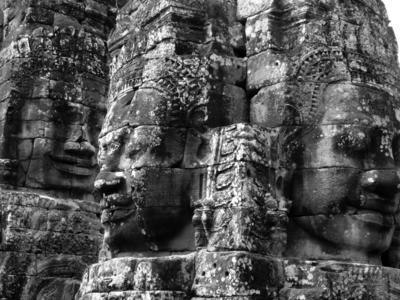From a distance, it seemed the jungle had taken its revenge on the eerie mass of jumbled rocks known as Bayon. I approached it in awe as hundreds of faces began to emerge from the tangled mass of stone and shadow. 54 towers chaotically assaulted the sky, each in its own plain, creating an intimidating sense of height.
When Chinese ambassador Zhou Daguan visited Angkor before the dawn of the 14th century, the city was dripping with the gold and riches of empire.
"At the center of the Kingdom rises a Golden Tower flanked by more than twenty lesser towers and several hundred stone chambers," Zhou wrote.
"On the eastern side is a golden bridge guarded by two lions of gold, one on each side, with eight golden Buddhas spaced along the stone chambers."
The"golden" period of the Khmer Empire was not a peaceful one. Rival powers from present-day Vietnam, Thailand, and Burma struggled with the Khmers for regional domination. Ironically, the Khmers' architectural prowess aided in their demise, as extensive temple construction, combined with frequent military conflicts, eventually drained the empire's resources. As the empire declined, Angkor was sacked several times, the gold and jewels stripped as spoil by invading armies. Bayon was one of the last great achievements of the empire, but fell in 1432 to the Thais, and was soon after forgotten.
The gold and jewels may be gone, but the mystique and grandeur of the Khmer kingdom endures.

A translation of King Jayavarman VII`s mystic Buddhist beliefs, Bayon is a spiritual experience. From each of the survivng towers the enlightened grin of the Boddhisattva Avalokitesvara, one of the most worshipped divinities in Mahayana Buddhism and the kingdom's principal divinity, compassion radiates out in the four cardinal directions. Carved in the likeness of the King himself (his portrait is known from other sculptures found elsewhere in Cambodia and Thailand), these enigmatically smiling faces portray the King as god, symbolizing his omnipresence and omnipotence.
The Khmer Smile.
Bodhisattva Avalokitesvara is believed to be the embodiment of compassion. A bodhisattva is motivated by compassion to seek enlightenment for all beings. The 216 faces haunting the heights of Bayon project benevolence outward in all directions, and are believed to bring hope, happiness, peace, and protection to all, especially those living in the Khmer Empire.

As I wandered around in wonder, watched by the eyes of Big Brother, Bayon-style, I couldn't help but feel like I was trapped in an MC Escher drawing. I don't think I could ever have believed such a place existed, even in my dreams, and I certainly never imagined that someday I would see it with my own two eyes.

No comments:
Post a Comment